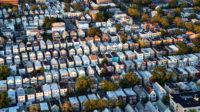October Editor's Letter: The Survival of Cities, Mankind's Greatest Invention

On the cover of RECORD this month is a striking building, Stone Garden, in Beirut. The 13-story apartment tower—designed by Lina Ghotmeh, a French Lebanese architect based in Paris—is angled onto its tight urban site and wears a striated skin, cut with deep apertures, out of which spill profusions of greenery. The design was inspired, says the architect, by the brutal history of conflict in the city of her childhood. “Violence had always left its mark on the city’s building skins, hollowing these and leaving nature to invade every left-out concrete skeleton,” she writes. “In Beirut, you are invited to change your understanding of what a facade opening might mean.”
RECORD contributing photographer Iwan Baan, who brought this project to our attention, photographed it early this year, before the pandemic lockdown. Joumana Ghandour Atallah, a Beirut-based architect, was commissioned to visit the building and report on it for this issue.
Then, on August 4, a huge blast rocked Beirut, this time not from a bomb or artillery but from an explosion in a warehouse in the port—a mere 1,500 feet from Stone Garden—killing at least 190 people and injuring many more. Features editor Josephine Minutillo immediately reached out to Ghotmeh and Atallah and learned that they were OK and that the building, though damaged, was structurally sound. Most of its windows were blown out—but the plantings in the openings were still thriving. We decided we had to go ahead and publish it.
Few cities have endured what Beirut has faced, and few are as resilient. And in its long, scarred history, the jewel of the Mediterranean has exemplified what the economist Edward Glaeser and others mean when they call cities mankind’s greatest invention.
But right now, in the U.S., cities are viewed with skepticism. Metropolitan areas have taken a huge economic hit because of Covid, and people are expressing fear of the density and social and cultural interactions that make cities vibrant and alive. And though urban areas are now opening up again—and an eventual vaccine seems to be on the horizon—in this issue of RECORD, we ask the hard question: “Are Cities Over?”. What will it take for cities to recover economically? And if they do recover, will urban leaders grab the opportunity to improve them and finally deal with long-standing inequities in housing and public access that can make civic life open and fair to all?
For those millions who remain committed to urban living, we offer several varied, inspiring, multifamily-housing projects in this issue (even one apartment complex out in the country). From the Continental in San Diego, by Jonathan Segal, with its clever open plan and balconies, at an affordable rent; to LOHA’s first building for the City Modern development in Detroit, a new ground-up neighborhood in a once wealthy part of the city and the urbane Cable Mills apartment complex by Merge Architects in bucolic Williamstown, Massachusetts; and Alex Gorlin’s South Bronx housing, a model of good design, with ample daylight and refined detailing brought to a handsome low-income project, these works of architecture reflect some of the diverse and lively ways to reimagine dwelling in the city.
Cities have a long history of post-crisis resilience. While it seems at the moment that many American cities are failing, we can’t forget the determination of those who live in them—the majority of residents unable to leave during the pandemic, and those who would never want to leave—who, despite the efficiency of connecting remotely, find the “real, live, inspiring human energy” of the city irreplaceable, as that great urban philosopher Jerry Seinfeld recently put it in The New York Times. RECORD will continue to report on the future of cities—how they are evolving, and how commerce and creativity can begin to thrive again, like a garden growing from stone.




